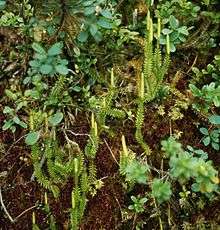Lycopodium
| Lycopodium | |
|---|---|
 | |
| Lycopodium annotinum | |
| Scientific classification | |
| Division: | Lycopodiophyta |
| Class: | Lycopodiopsida |
| Order: | Lycopodiales |
| Family: | Lycopodiaceae |
| Subfamily: | Lycopodioideae |
| Genus: | Lycopodium L. |
| Species | |
|
See text | |
Lycopodium (from Greek lukos, wolf and podion, diminutive of pous, foot) is a genus of clubmosses, also known as ground pines or creeping cedar,[1] in the family Lycopodiaceae, a family of fern-allies (see Pteridophyta). They are flowerless, vascular, terrestrial or epiphytic plants, with widely branched, erect, prostrate or creeping stems, with small, simple, needle-like or scale-like leaves that cover the stem and branches thickly. The leaves contain a single, unbranched vascular strand and are microphylls by definition. The kidney-shaped or reniform spore-cases (sporangia) contain spores of one kind only (isosporous, homosporous) and are borne on the upper surface of the leaf blade of specialized leaves (sporophylls) arranged in a cone-like strobilus at the end of upright stems. The club-shaped appearance of these fertile stems gives the clubmosses their common name.
Lycopods reproduce asexually by spores. The plants have an underground sexual phase that produces gametes, and this alternates in the lifecycle with the spore-producing plant. The prothallium developed from the spore is a subterranean mass of tissue of considerable size and bears both the male and female organs (antheridia and archegoniae). However, they are more commonly distributed vegetatively through above- or below-ground rhizomes.
About 76 accepted species occur,[2] with 37 species widely distributed in temperate and tropical climates, though they are confined to mountains in the tropics.
The genera Diphasiastrum, Lycopodiella, and Huperzia were once included within this genus, but are now recognized as being distinct. Some workers also segregate several more genera, including Dendrolycopodium for L. obscurum and related species, and Spinulum for L. annotinum and related species.
The spores of Lycopodium and Diphasiastrum species are harvested and are sold as lycopodium powder.
Species
Section Lycopodium
- Lycopodium aberdaricum (central and southern Africa)
- Lycopodium alboffii (southernmost South America and the Falkland Islands)
- Lycopodium centrochinense (east Asia (central China to India and the Philippines); treated as a synonym of L. japonicum by some authors)
- Lycopodium clavatum (stag's-horn clubmoss; subcosmopolitan, see species article for details)
- Lycopodium diaphanum (Tristan da Cunha)
- Lycopodium hygrophilum (New Guinea)
- Lycopodium interjectum (southwest China (Sichuan); treated as a synonym of L. japonicum by some authors)
- Lycopodium japonicum (eastern Asia (Japan west and south to India and Sri Lanka))
- Lycopodium lagopus (circumpolar arctic and subarctic)
- Lycopodium papuanum (New Guinea)
- Lycopodium pullei (New Guinea)
- Lycopodium simulans (southwest China (Yunnan); treated as a synonym of L. japonicum by some authors)
- Lycopodium taliense (southwest China (Yunnan); treated as a synonym of L. japonicum by some authors)
- Lycopodium venustulum (Hawaii, Western Samoa, Society Islands)
- Lycopodium vestitum (northwest South America (Andes))
Section Obscura (genus Dendrolycopodium)
- Lycopodium dendroideum (northern North America)
- Lycopodium hickeyi (northeastern North America)
- Lycopodium juniperoideum (northeast Asia (central Siberia southeast to Taiwan))
- Lycopodium obscurum (northeast North America, northeast Asia)
- Lycopodium verticale
Section Annotina (genus Spinulum)
- Lycopodium alticola (southwest China)
- Lycopodium annotinum (stiff clubmoss or interrupted clubmoss; circumpolar north temperate)
- Lycopodium canadense
- Lycopodium dubium (cold temperate and subarctic Europe and Asia; treated as a synonym of L. annotinum by some authors)
- Lycopodium neopungens (China)
- Lycopodium subarcticum (northeast Siberia)
- Lycopodium zonatum (southeast Tibet)
Section Diphasium
- Lycopodium gayanum (south-central Chile and adjacent westernmost Argentina)
- Lycopodium jussiaei (northern South America, Caribbean)
- Lycopodium scariosum (southeastern Australia, New Zealand, Borneo (Mount Kinabalu))
Section Lycopodiastrum
Section Magellanica (genus Austrolycopodium)
- Lycopodium assurgens (Brazil (Minas Gerais, Santa Catarina))
- Lycopodium confertum (southern South America and the Falkland Islands)
- Lycopodium fastigiatum (southeastern Australia, New Zealand)
- Lycopodium magellanicum (South and Central America (Andes), southern Atlantic Ocean and southern Indian Ocean islands)
- Lycopodium paniculatum (southern South America (Andes))
Section Pseudolycopodium
- Lycopodium deuterodensum, tree club moss (eastern Australia, New Caledonia, New Zealand) — has appressed leaves; height approximately 600 mm
Section Pseudodiphasium
- Lycopodium spectabile (Java)
- Lycopodium volubile, climbing club moss (southwest Pacific Ocean islands (New Zealand north to Java), Australia (Queensland)) — found along bush margins and disturbed ground; has a creeping habit and can climb up vegetation
Uses
Lycopodium sp. herb has been used in the traditional Austrian medicine internally as tea or externally as compresses for treatment of disorders of the locomotor system, skin, liver and bile, kidneys and urinary tract, infections, rheumatism, and gout,[3] though claims of efficacy are unproven. It has also been used in some US government chemical warfare test programs such as Operation Dew. Lycopodium powder is also used to determine the molecular size of oleic acid.
References
- ↑ The Columbia Encyclopedia, Sixth Edition, 2008
- ↑ "The Plant List: Lycopodium". Royal Botanic Gardens kew and Missouri Botanic Garden. Retrieved 12 February 2017.
- ↑ Vogl, S; Picker, P; Mihaly-Bison, J; Fakhrudin, N; Atanasov, A. G.; Heiss, E. H.; Wawrosch, C; Reznicek, G; Dirsch, V. M.; Saukel, J; Kopp, B (2013). "Ethnopharmacological in vitro studies on Austria's folk medicine--an unexplored lore in vitro anti-inflammatory activities of 71 Austrian traditional herbal drugs". Journal of Ethnopharmacology. 149 (3): 750–71. doi:10.1016/j.jep.2013.06.007. PMC 3791396. PMID 23770053.
External links
| Wikimedia Commons has media related to Lycopodium. |
- Species list (takes a broad view of the genus, including the species here separated in the genus Diphasiastrum)
- Burning Lycopodium Powder: Simulating a Grain Elevator Explosion by Kevin A. Boudreaux